Texas Majority PAC Redistricting Analysis
Introduction
Donald Trump asked Greg Abbott for five congressional seats, and the maps that just passed are well-drawn to maximize opportunity without putting Republicans at risk. This map is unlikely to be a “dumbymander”, wherein safe red districts become competitive when too many Democrats are drawn in to destroy blue districts. Democrats have been packed into already blue districts, creating newly competitive districts in the areas where they were drawn out.
Texas is already one of the most gerrymandered states in the country. Democrats currently only hold 30% of Texas’ 38 Congressional seats, despite the fact that approximately 45% of registered Texas voters are Democrats. Herein lies the problem for Republicans with the new map–there is only so much that can be done to create new red seats in a state already so deeply gerrymandered.
The strategy behind the map that just passed the House and will be agreed to by the Senate is based on two assumptions: (1) that Trump 2024 support numbers are a reliable metric by which to draw new districts; and (2) that Latino voters will continue to shift or, at minimum, hold at their 2024 support levels for the GOP in 2026. Available data and research indicates these are flawed assumptions.
Ultimately, it is almost guaranteed that Texas Republicans will net congressional seats in 2026. But picking up all five is unlikely. We believe CD 28 and CD 34 are the two most likely to be held by the incumbent members. We also think it’s possible, though admittedly difficult, to hold CD 35. CD 32 and CD 9 are all but guaranteed to flip red. Finally, we think that CD 15, which is currently held by a Republican and was not a focus of the redistricting effort, will be the most competitive it’s been since 2020 redistricting.
This report challenges the underlying assumptions of the new maps, and presents the realistic pathway that exists for Texas Democrats to hold at least some of these newly-competitive seats. It also describes the ways in which Texas Majority PAC intends to do our part in realizing these goals. With the balance of the US House–and therefore the future of the nation–at stake, everyone must do everything in their power to hold as many of these five seats as possible.
Challenging the GOP's assumptions
Assumption #1: 5 blue districts become Trump +10 based on 2024 numbers and are therefore unholdable
The new map is intended to create the opportunity to flip CD 32 (Julie Johnson), CD 9 (Al Green), CD 35 (Greg Casar), CD 28 (Henry Cuellar), and CD 34 (Vicente Gonzalez). All of these will now be at least Trump +10 districts by 2024 numbers. CD 32 was aggressively redrawn and is now Trump +20, making it unlikely to be winnable this cycle, even in a giant blue wave scenario. It has also become significantly whiter and not likely to have favorable demographic shift longterm; accordingly, we’re not addressing CD 32 further in this report.
But judging opportunities present in the remaining four districts by Trump ‘24 numbers is misleading. We know now, based on ‘24 election results and from polling before and since Election Day, that Kamala Harris and the Biden administration were deeply unpopular in these newly re-drawn districts. Based on polling from Blue Rose Research, we know that Harris’ favorability was as low as Trump’s by Election Day 2024 (-6%, and that the Biden administration’s favorability was -20%). Voters trusted Republicans to solve the issues that mattered most to them more than they trusted Democrats. Therefore, on Election Day, Trump improved on his 2020 performance with every single type of voter–by age, race, gender, and geography–and in almost every single county in the country.
This was not true in downballot races, where Democrats fared much better than Harris. Senate Democrats retained their seats in four states that Harris lost, and Congressional Democrats outperformed Harris in almost 50% of districts. By contrast, no Senate Democrat won in a state that Clinton lost in 2016. We saw this in Texas, too, where Colin Allred outperformed Harris by 5.5%, one of the largest overperformances in the country, and every single congressional Democrat did better in their districts than Harris did.
We know that 2026 is likely to be a much better cycle for Democrats up and down the ballot than 2024. Donald Trump is a Republican turnout machine, but he’s also deeply unpopular. With him off the ballot and in the White House, we can reasonably expect 2026 to be more like 2018 than ‘24, ‘22, or ‘20. If we look back at Beto O’Rourke’s 2018 performance in these new districts, we see that Democrats performed significantly better than even Allred’s ‘24 overperformance.
| Target Districts | Harris 2024 | Allred 2024 | Beto 2018 |
|---|---|---|---|
| 28 | 48% | 49% | 66% |
| 34 | 44% | 48% | 55% |
| 35 | 44% | 47% | 49% |
| 15 | 41% | 44% | 55% |
| 9 | 40% | 43% | 50% |
This chart leads to the next faulty assumption:
Assumption #2: Latino voters will continue to shift towards or at least maintain their 2024 levels of support for Republicans.
These districts will be won or lost depending on how Texas Latinos vote this cycle. Most of these districts have a greater number of Latino voters in them now than the old map. The key data point here is that there is a distinction between Latino support for Republicans writ large and for Donald Trump specifically. According to precinct-level analysis, Allred overperformed Harris in these districts in large part because more Latino Democrats turned out to vote for him and fewer Latino voters switched parties to vote against him. Donald Trump won Hidalgo County (the largest county in South Texas), but all down-ballot Democrats in Hidalgo County retained their seats.
Based on analysis from Equis Research, Trump’s strong performance with Latino voters was due to three things: (1) he drove turnout amongst first-time voting Latinos; (2) he persuaded a meaningful number of Latinos who voted for Biden in 2020 to vote for him in 24; and (3) a meaningful number of Latino Democrats sat out voting altogether, unhappy with Democrats but unwilling to vote for Trump.
So the relevant questions are: how will Latinos who supported Trump in 2024 vote in 2026, and can Latino Democrats who sat out 2024 be compelled to vote for Democrats in 2026?
There is some early polling that shows Latinos are growing discontent with Trump, just as all other voters in the country are. According to Equis polling in May and July, Trump’s job approval amongst Latinos is on the decline. Among those who voted in for Biden in 2020 and Trump in 2024, only half currently approve of Trump’s job performance, and only a third say they are committed to voting for Republicans in 2026.
Research shows that one of the best early predictors of midterm performance is generic ballot polling. Every single generic ballot poll from a reputable pollster in the last two months has shown that Democrats currently hold the generic ballot advantage, from 2-8%. Ultimately, the reason Republicans are trying to steal seats in Texas is the very reason why we think this map will not produce five new red seats: MAGA is more unpopular by the day. If this keeps up, voters of all ages, races, genders, and geographies will move away from Trump and the Republican congressmembers who have supported his agenda.
District Analysis
CD 28
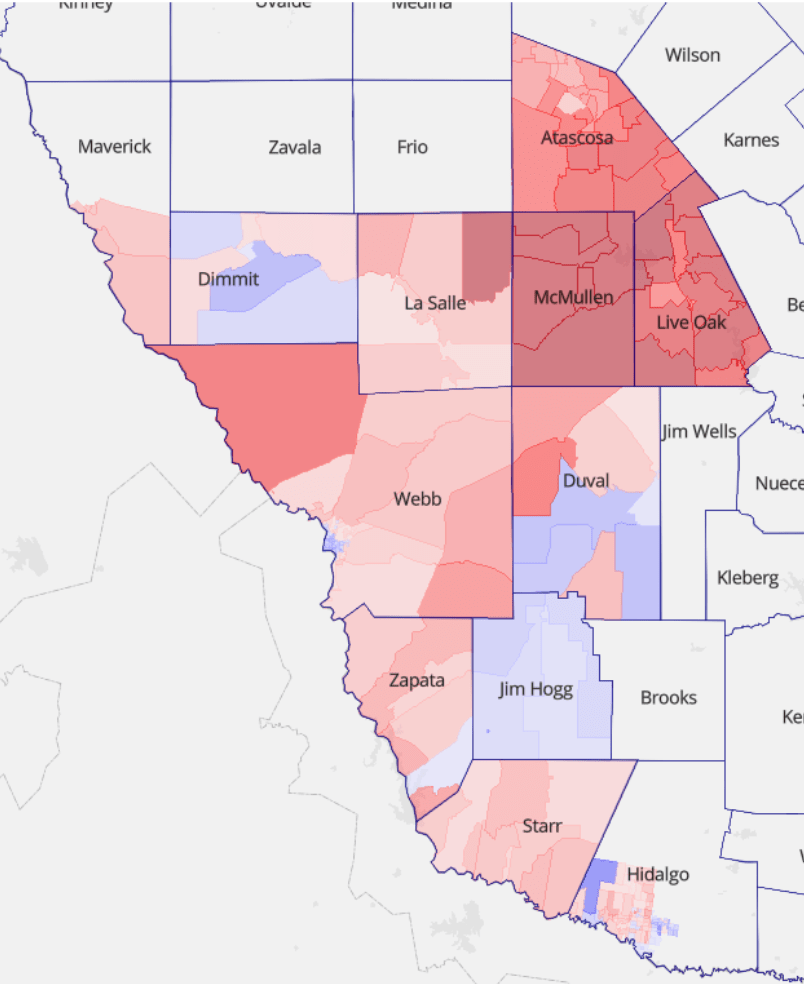
The new CD 28 is the most likely to be held by Democrats. Rep. Cuellar has proven to be uniquely popular in South Texas; he outperformed Harris by 8% in his old district. The new district still contains Webb (Laredo) and surrounding counties, and it now includes parts of McAllen, which Cuellar represented before the last round of redistricting in 2020. The new district has a larger percentage of Latino voters (89%) than the old one. We assume based on available data that Latino support for Democrats will be better than last cycle but not reach 2018 levels of support. We estimate Democrats need to net 7,000-10,000 additional votes to win (3-5% increase).
CD 34
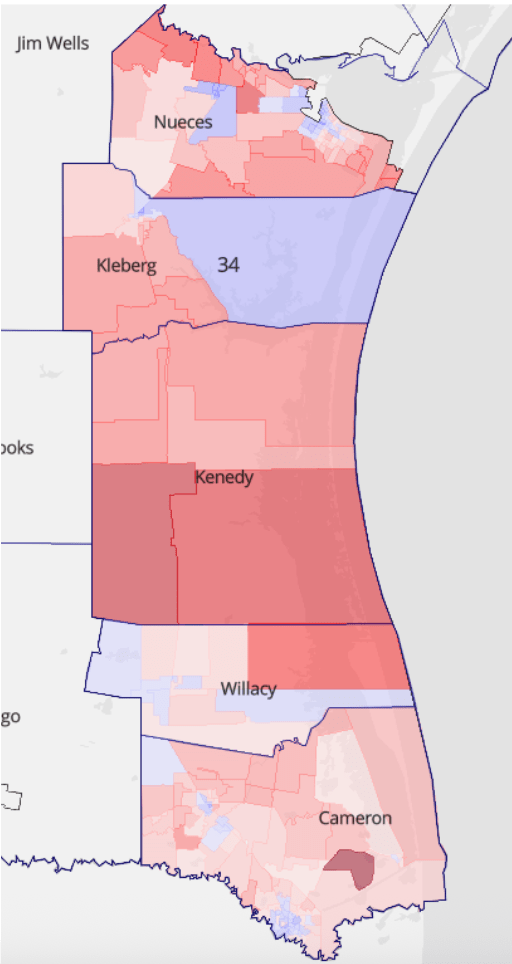
The new CD 34 has a good chance of being held by Democrats. Rep. Gonzalez overperformed Harris by 4% in his old district. The district contains parts of Corpus Christi in the north, and contains all of Kleberg, Kenedy, Willacy, and Cameron Counties. The vast majority of voters in this district live in Cameron and Nueces Counties (Corpus Christi). 71% of the electorate is Latino. We estimate Democrats need to net 15,000-20,000 additional votes to win (7-10% increase).
CD 35
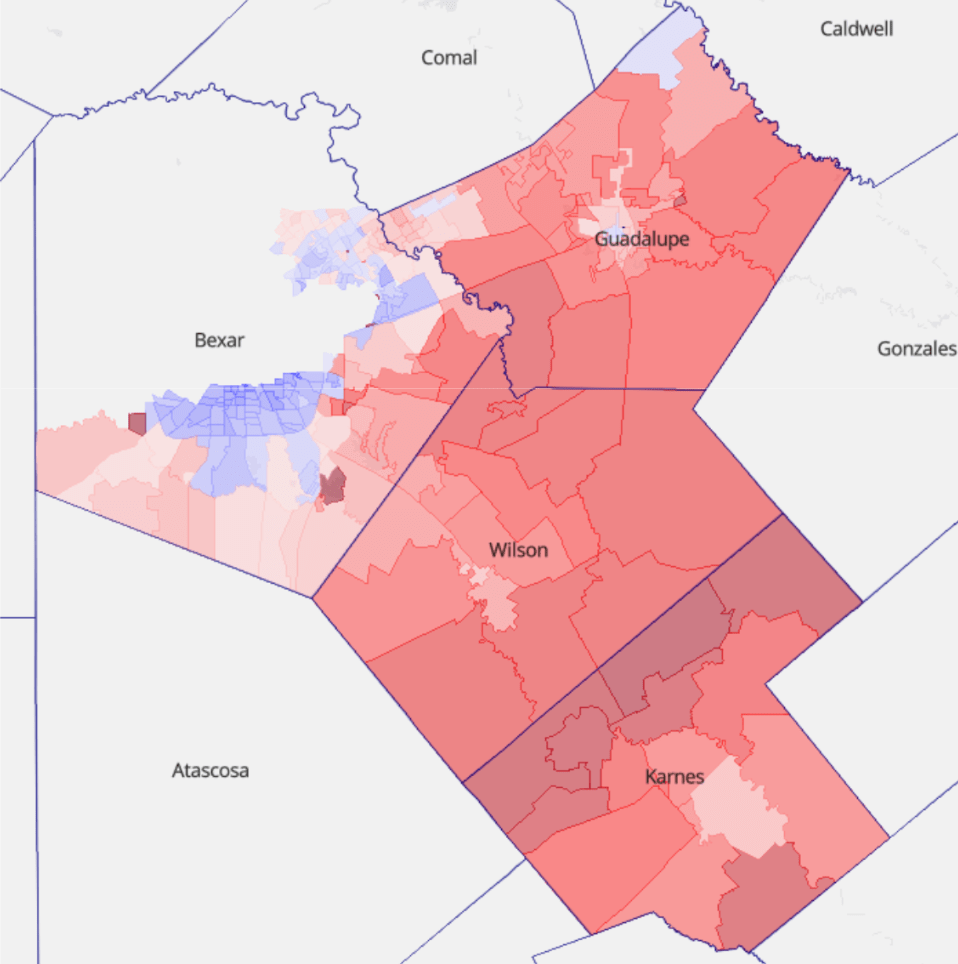
The new CD 35 no longer contains any parts of Austin, but holds some of the blue parts of northern and southern Bexar County (San Antonio), and the neighboring red counties of Guadalupe, Wilson, and Karnes counties. Just under half the electorate lives in Bexar County, and it is about evenly split between white and Latino voters. While there are technically more likely Democrats in CD 35 than Republicans, likely Democrats are infrequent voters compared to the Republicans. The white turnout rate is much higher than the Latino turnout rate in this district. This will be a challenging district to win, especially with no Democratic incumbency advantage. We estimate Democrats need to net 14,000-21,000 additional votes to win (7%-10%).
This district is unlikely to be won by Democrats in 2026, but it is rapidly growing and shifting. It is likely that the demographic and partisan makeup of this district will look different in the next 2-6 years as Democrats are priced out of inner city San Antonio, in which case CD 35 would become more competitive. In a big blue wave year with a great candidate, winning in 2026 is not totally out of the question. But even if it is not won this cycle, investing in CD 35 now will pay dividends in the future when it becomes more competitive.
CD 9
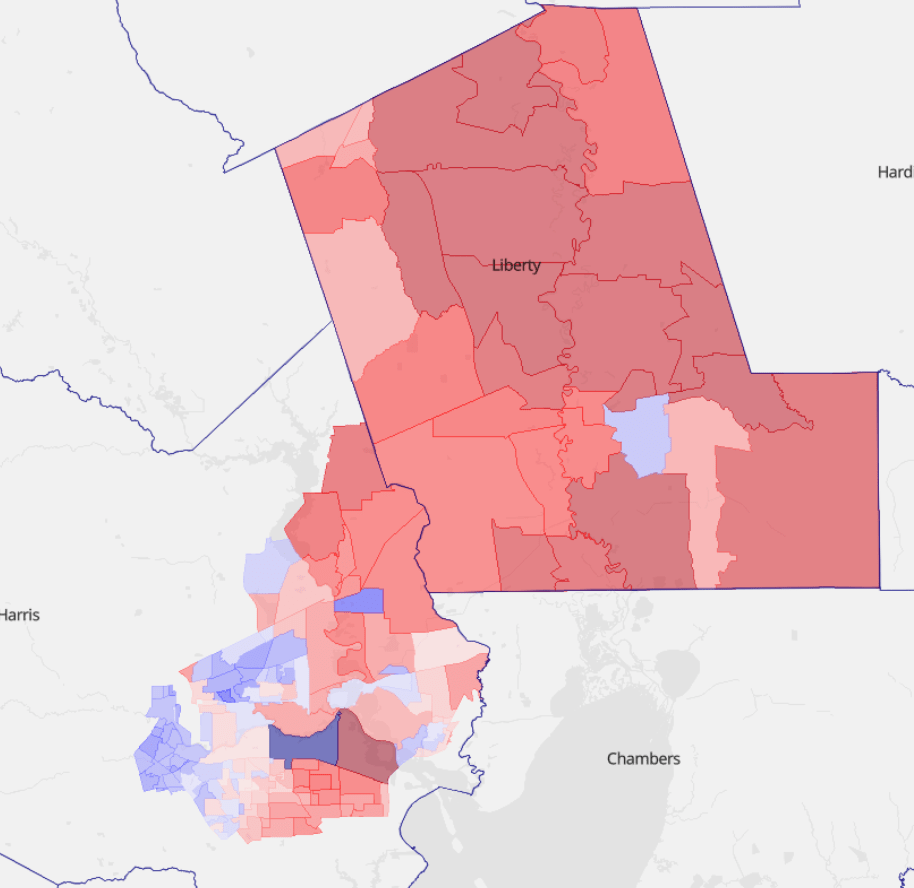
The new CD 9 contains parts of eastern Harris County and stretches eastward through Liberty County. About a third of the electorate lives in Harris County. It has a plurality of Latino voters now, and most of the Black voters from the old CD 9 have been drawn out. Like CD 35, the likely Democrats in this district are infrequent voters compared to the likely Republicans. We estimate Democrats need to net 10k-15k additional votes to win (9%-12%).
This district is unlikely to be held by Democrats in 2026. But also like CD 35, this district is experiencing a rapid demographic shift. It may be more competitive within the next few cycles, and competing now is important to win it back in the future.
CD 15
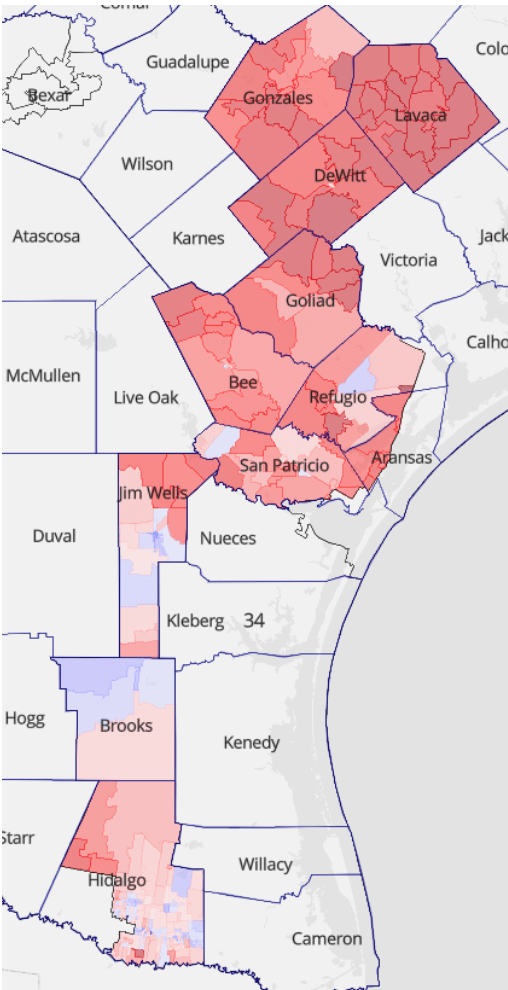
CD 15 is the only possible red-to-blue flip opportunity for Texas Democrats this cycle. Redistricting left the margins in CD 15 virtually identical to the old district. It contains part of Hidalgo County and stretches all the way up Gonzales and Lavaca counties in the north. 76% of the electorate is Latino. The majority of voters live in Hidalgo County, which was won by Trump in 2024 but lost by all other downballot Republicans. Whether or not CD 15 can be flipped depends on Democratic performance in Hidalgo County. While there are many likely Democrats in this district, they are less likely to strongly support their party and to vote than the likely Republicans are.
CD 15 is a longshot, but not impossible. It will require a strong candidate, and we believe that Bobby Pulido, should he choose to run, is very strong. He will start with a higher name recognition and more favorable profile than the average first-time candidate, and has high potential to run a robust small dollar fundraising program. A strong candidate, coupled with a large-scale persuasion and turnout program, and favorable national conditions, could put this district in the Democratic column for the first time since 2020 redistricting. We estimate Democrats need to net 15,000-19,000 votes to win in 2026 (8%-11%).
Texas Majority PAC's Plan to Win
Our goal at TMP is to turn Texas blue by 2032. We are not necessarily focused on holding or flipping congressional districts and we do not spend much of our time or resources on very red counties. However, this map presents us with the opportunity to do two things at once. Each of these districts at least partially contains blue population hubs that are part of our statewide priorities: Houston, San Antonio, Laredo, Corpus Christi, McAllen, and Brownsville. So, where we can kill multiple birds with one stone, we will. One example of crossover priorities is in Bexar County– in order to win statewide, we need much greater Democratic turnout in San Antonio, and the southern part of the county is one area that has hundreds of thousands of non-participating Democrats. That region also holds a large portion of the CD 35 and the HD 118 (a highly competitive state house seat) electorate. We will run a robust voter turnout program in that area that carries the faces and names of the statewide, congressional, and state house candidates.
Each of the cities named in the above paragraph are a key part of our statewide path to victory, and victory in the new congressional districts will run through them, too. Therefore, our statewide strategy will aid in holding or flipping the CDs mentioned in this analysis.
We have a three-pronged strategy to flip the state:
- We must run large scale volunteer and paid voter turnout programs to turn non-participating Democrats into voters.
- We need Democrats to run for office at every level of the ballot all over the state.
- We need Democrats to run better campaigns that spend more money on voter contact and use best practices to more effectively persuade and turnout voters.
Therefore, TMP is running three major programs this cycle: volunteer and paid voter turnout, candidate recruitment, and campaign services. We are doing this through the Blue Texas project, the coordinated effort between TMP, the Texas Democratic Party, and county parties across the state.
- Voter turnout program
We know a lot about how to make people more likely to vote, thanks to decades of randomized controlled trials (RCTs), the gold standard of scientific research. Mail, radio, television, canvassing, calling, and texting are all well-studied and found to be effective at turning out voters when utilizing best practices. Other tactics like relational organizing and communicating through non-traditional media are also promising, though require more study. In our view, Texas Democrats need to be doing all of these things in order to win.
TMP focuses on running the volunteer and paid field program for the state to relieve the statewide and down ballot candidates of the associated financial and operational burden of doing so themselves. This cycle, we will knock millions of doors, make tens of millions of calls, and write millions of letters to Democrats who are unlikely to vote without a nudge close to Election Day. This will require hiring hundreds of full-time organizers and thousands of paid canvassers, and organizing tens of thousands of volunteers across the state. Last cycle we knocked almost 2 million doors, made over 5 million calls, and wrote over 500,000 letters. This cycle we hope to at least double our program. And thanks to new campaign finance rules that TMP pursued last cycle, we can do all of this in coordination with county parties, the state party, and federal candidates.
To that end, Blue Texas hosted organizing rallies in every major city to recruit volunteers into our summer phone banking program. Thanks to the TDP, the county parties, and guest speakers like Rep. James Talarico, Rep. Colin Allred, Senator Wendy Davis, Rep. Jasmine Crockett, and others, more than 5,000 people signed up to volunteer this year. And we’ve already put them to work, calling Democrats who didn’t vote in 2024 to ask them why they sat it out and what would compel them to vote in 2026. To date, Blue Texas volunteers have already made more than 500,000 calls. - Candidate recruitment
Last cycle, 5 congressional and 22 state house seats went uncontested, as well as hundreds of down ballot seats. This cycle, TMP will make sure that every single congressional, state house, and state senate seat is filled with a legitimate, hard-working, high-quality Democrat. We began our recruitment program in July with a statewide tour; our candidate team held rallies in the 24 biggest cities in districts that are typically uncontested and asked the rally attendees to nominate people in their own lives that they think would be excellent candidates. We received 500 nominations during the tour, thanks in part to guests like Beto O’Rourke, Rep. James Talarico, Rep. Colin Allred, and Senator Wendy Davis.
Oftentimes, Democrats in red areas aren’t given the opportunity to vote for Democrats below the top of the ticket because nobody runs. Most of these voters aren’t even getting any contact from Democratic campaigns because of where they live. We need ordinary, hard-working Texans who have personally experienced the effects of Republican rule to run and make the case that life can be better in Texas–nurses working in hospitals that are over capacity, workers who are struggling to make ends meet on minimum wage, parents whose kids’ schools have closed because of underfunding.
Given the much higher number of nominations than anticipated, we believe we will fill many more seats with candidates further down the ballot than just the typically uncontested congressional, state house, and state senate seats. Many of these are very challenging seats in red areas. But if we can hold to a better margin in the rural areas of the state, we will see a lift at the top of the ticket. And in a massive blue wave year, all sorts of things are possible. We aren’t going to leave wins on the table just because we didn’t try. The TMP candidate team will do another tour in the fall to fill any remaining vacancies and continue recruiting further down the ballot. - Campaign services
Even when a Democrat does decide to run for office in Texas, they are often left on their own to figure it all out. Many of them have never run for office before, have little money, no staff, and no sense of what they should and shouldn’t be doing in order to win. TMP and Blue Texas are changing that. Candidates we recruit will receive the following services that will run through Election Day:- A TMP staffer who will help candidates launch their campaign, write a campaign plan, and build a candidate schedule
- Cost assistance with things like filing fees, VAN fees, fundraising platforms, dialers, and texting platforms
- Media booking
- Legal and compliance support
- An organizing program in their district that they can plug into. We will have full-time field staff in the major urban and suburban counties, and a team of full-time distributed organizers who manage all other counties of the state.
- Data, polling, and analysis will be shared with all candidates as broadly as we can within the limits of the law.
- We will negotiate cost-sharing deals with vendors to bring prices down for all Texas clients who use them.
- We will offer some services, like texting, either for free or at-cost (depending on the legal requirement). Campaigns are currently paying far too much money to consultants through markups they don’t even know exist. We aim to disrupt this practice and get campaigns to spend as much of their budgets on things that actually move the needle on Election Day, not on hidden consulting fees.
By running a large-scale voter turnout program in the blue areas of these CDs, and by recruiting downballot candidates and helping them run better campaigns in counties within these districts, TMP and the whole Blue Texas team–the TDP and various county parties–intend to compete as hard as possible in these districts.
Conclusion
Donald Trump demanded five seats from Greg Abbott, but it is not a foregone conclusion that he gets all five. CD 32 and CD 9 will almost certainly flip red. CD 35 has a small chance with the right candidate. We can hold onto CD 28 and CD 34 with great campaigns and serious investment in every form of voter persuasion and turnout. And we have a shot at picking up CD 15. We urge donors and institutions to include Texas in their plans for the 2026 cycle. The Democratic ecosystem in Texas has never been better organized than it is right now, and the losses we take in some of these seats this cycle can be recovered more easily in the future with investment now. The balance of the House will likely come down to a handful of seats, and every single win will matter.
